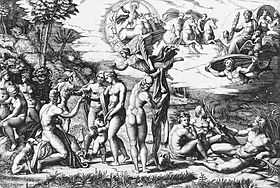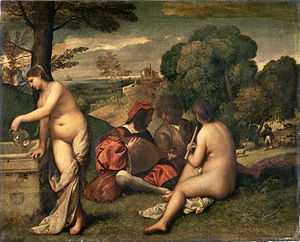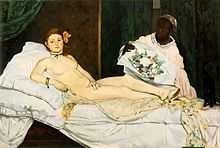Le Déjeuner sur l’herbe
| French: Le Déjeuner sur l'herbe | |
|---|---|
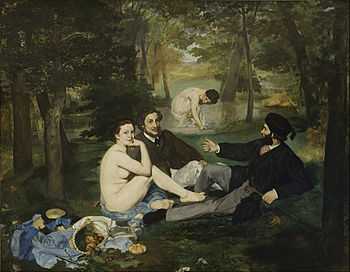 | |
| Artist | Édouard Manet |
| Year | 1862–1863 |
| Type | Oil on canvas |
| Dimensions | 208 cm × 265.5 cm (81.9 in × 104.5 in) |
| Location | Musée d'Orsay, Paris |
Le Déjeuner sur l'herbe (English: The Luncheon on the Grass) – originally titled Le Bain (The Bath) – is a large oil on canvas painting by Édouard Manet created in 1862 and 1863. The painting depicts a female nude and a scantily dressed female bather on a picnic with two fully dressed men in a rural setting. Rejected by the Salon jury of 1863, Manet seized the opportunity to exhibit this and two other paintings in the 1863 Salon des Refusés[1] where the painting sparked public notoriety and controversy. The piece is now in the Musée d'Orsay in Paris.[2] A smaller, earlier version can be seen at the Courtauld Gallery, London.[3]
Description and context
The painting features a nude woman casually lunching with two fully dressed men. Her body is starkly lit and she stares directly at the viewer. The two men, dressed as young dandies, seem to be engaged in conversation, ignoring the woman. In front of them, the woman's clothes, a basket of fruit, and a round loaf of bread are displayed, as in a still life. In the background a lightly clad woman bathes in a stream. Too large in comparison with the figures in the foreground, she seems to float above them. The roughly painted background lacks depth – giving the viewer the impression that the scene is not taking place outdoors, but in a studio. This impression is reinforced by the use of broad "photographic" light, which casts almost no shadows. The man on the right wears a flat hat with a tassel, of a kind normally worn indoors.
Despite the mundane subject, Manet deliberately chose a large canvas size, measuring 208 x 264cm, normally reserved for historical, religious, and mythological subjects.[4] The style of the painting breaks with the academic traditions of the time. He did not try to hide the brush strokes; the painting even looks unfinished in some parts of the scene. The nude is also starkly different from the smooth, flawless figures of Cabanel or Ingres.
A nude woman casually lunching with fully dressed men was an affront to audiences' sense of propriety, though Émile Zola, a contemporary of Manet's, argued that this was not uncommon in paintings found in the Louvre; he also felt that such a reaction came from viewing art differently than "analytic" painters like Manet, who use a painting's subject as a pretext to paint.
There is much that we still do not know about the painting such as when he actually began painting it, exactly how he got the idea, and how and what sort of preparation works he did.[5] Though Manet had claimed this piece was once valued at 25,000 Francs in 1871, it actually remained in his possession until 1878 when Jules Faure, opera-singer and collector, bought it for just 2,600 Francs.[6]
Figures in the painting
The figures of this painting are a testament to how deeply connected Manet was to Le Déjeuner sur l’herbe. Some assume that the landscape of the painting is meant to be Ile Saint-Oeuen, which was just up the Seine from Gennevilliers, where his family property was. Manet often used real models and people he knew as reference during his creation process.[7] The female nude is clearly thought to be Victorine Meurent, the woman who became his favorite and frequently portrayed model, that later was the subject of Olympia. The male figure on the right was based on a combination of his two brothers, Eugène and Gustave Manet. The other man is based on his brother-in-law and Dutch sculptor named Ferdinand Leenhoff. Nancy Locke referred to this scene as Manet’s family portrait.[8]
The interactions of the figures
What many critics find shocking about this painting is the interaction, or lack thereof, between the three main subjects in the foreground and the woman bathing in the background. There are many contrasting qualities to the painting that juxtapose and distance the female nude from the other two male subjects. For example, the feminine versus the masculine, the naked versus the clothed, and the white color palette versus the dark color palette creates a clear social difference between the men and the woman.[9] Additionally, viewers are intrigued by the questions raised by the gaze of the nude woman. It is indeterminable whether she is challenging or accepting the viewer, looking past the viewer, engaging the viewer, or even looking at the viewer at all. This encounter identifies the gaze as a figure of the painting itself, as well as the figure object of the woman’s gaze.[10]
Inspirations
As with the later Olympia (1863), and other works, Manet's composition reveals his study of the old masters, as the disposition of the main figures is derived from Marcantonio Raimondi's engraving The Judgement of Paris (c. 1515) after a drawing by Raphael.[11] Raphael was an artist revered by the conservative members of the Académie des Beaux-Arts and his paintings were part of the teaching programme at the École des Beaux-Arts, where copies of fifty-two images from his most celebrated frescoes were permanently on display. "Le Bain was therefore [-] in many ways, a defiant painting [-]Manet was cheekily reworking Raphael, turning a mythological scene from one of the most celebrated engravings of the Renaissance into a tableau of somewhat vulgar Parisian holidaymakers."[12]
-
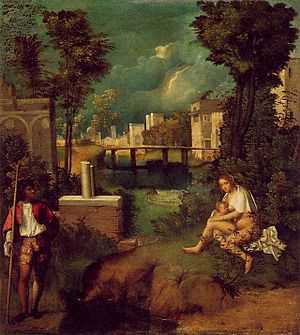
Giorgione, The Tempest (c. 1508). Gallerie dell'Accademia, Venice, Italy.
-

Antoine Watteau, La Partie Carrée, c. 1713
Scholars also cite two works as important precedents for Manet's painting Le Déjeuner sur l'herbe, The Pastoral Concert, 1508, by Giorgione or possibly Titian (in the Louvre) and Giorgione's The Tempest, both of which are famous Renaissance paintings.[13] The Tempest, which also features a fully dressed man and a nude woman in a rural setting, offers an important precedent for Manet's painting Le Déjeuner sur l'herbe.[14] The painting Pastoral Concert even more closely resembles Le Déjeuner sur l'herbe, as it features two dressed men seated in a rural setting, with two undressed women. Pastoral Concert is in the collection of the Louvre in Paris and is likely, therefore, to have been studied by Manet.
According to Proust, he and Manet had been lounging by the Seine as they spotted a woman bathing in the river. This prompted Manet to say, “I copied Giorgione’s women, the women with musicians. It’s black that painting. The ground has come through. I want to redo it and do it with a transparent atmosphere with people like those we see over there.”[15]
There may be a strong connection between Le Déjeuner sur l’herbe and the work of Jean Antoine Watteau.[16] Manet’s original title, Le Bain, initially drew the main attention to the woman near the water. This bathing figure alone is quite similar to the figure in Watteau’s Le Villageoise, as both women crouch or lean over near water, simultaneously holding up their skirts. It’s possible that Manet adapted this pose, which is more clearly seen in a sketch of his years before his creation of Le Déjeuner sur l’herbe.[17]
Critique and controversy
There were many mixed reviews and responses to Le Déjeuner sur l’herbe when it was first displayed, and it continues to yield a variety of responses. The initial response was characterized by its blunt rejection from the Paris Salon and the subsequent display of it in the Salon des Refusés. Though many were rooted in confusion about the piece, the critiques weren’t always completely negative.[18]
- Odilon Redon, for example, did not like it. There is a discussion of it, from this point of view, in Proust's Remembrance of Things Past.
- Le Capitaine Pompilius, a contributor for Le Petit Journal, thought the characteristically “male” colors of the piece brought the countryside into the salon, yet he did feel the painting itself was underdeveloped.[19]
- Castagnary, appreciator of realist works, identified it as a nice sketch but the painting itself created an absence of sincerity, and lost the definition of the anatomy of the subjects. He also described Manet’s painting technique as “flabby.”[19]
- Arthur Stevens, contributor for Le Figaro, praised Manet as a talented colorist that neglected form and modeling in this piece.[19]
- Thoré, Paul, and Louvet loved the energy of the colors in this piece but found the brush strokes to be uneven.[19]
One interpretation of the work is that it depicts the rampant prostitution that occurred in the Bois de Boulogne, a large park at the western outskirts of Paris, at the time. This prostitution was common knowledge in Paris, but was considered a taboo subject unsuitable for a painting.[20] Indeed, the Bois de Boulogne is to this day known as a pick-up place for prostitutes and illicit sexual activity after dark, just as it had been in the 19th century.
Critiques of the subject matter
- Louis Etienne characterized the painting as a puzzle, while describing the nude female as “a Bréda of some sort, as nude as possible, lolling boldly between two swells dressed to the teeth. These two persons look like high school students on holiday, committing a great sin to prove their manhood.”[21]
- Arthur Stevens simply just couldn’t understand what the painting was saying.[21]
- Didier de Montchaux found the subject to be “fairly scabrous.”[21]
- Thoré described the nude as an ugly and risqué subject matter, while describing the male on the right as one “who doesn’t even have the idea to take off his horrible padded hat outdoors…It’s the contrast of such as antipathetic animal to the character of a pastoral scene, with this undraped bather, that is shocking.”[21]
- Philip Hamerton, an English painter and contributor at the Fine Arts Quarterly, had an affinity for the characteristic photographic detail of the Pre-Raphaelite paintings. Though he did recognize the inspiration from Giorgione, he found Manet’s modern realism to be offensive in this situation. His disapproval of Manet and similar artists was related to the idea of indecency behind “vulgar men” painting nude women.[21]
General response
Though the peculiarity of the combination of one female nude with three clothed figures sparked mixed responses, the lack of interaction of the figures in addition to the lack of engagement by the nude woman provoked laughter instead of offense. Laughter as a response represses the sexual tension and makes the scene rather unthreatening to the viewer in the end.[22]
Commentary of Émile Zola
The Luncheon on the Grass is the greatest work of Édouard Manet, one in which he realizes the dream of all painters: to place figures of natural grandeur in a landscape. We know the power with which he vanquished this difficulty. There are some leaves, some tree trunks, and, in the background, a river in which a chemise-wearing woman bathes; in the foreground, two young men are seated across from a second woman who has just exited the water and who dries her naked skin in the open air. This nude woman has scandalized the public, who see only her in the canvas. My God! What indecency: a woman without the slightest covering between two clothed men! That has never been seen. And this belief is a gross error, for in the Louvre there are more than fifty paintings in which are found mixes of persons clothed and nude. But no one goes to the Louvre to be scandalized. The crowd has kept itself moreover from judging The Luncheon on the Grass like a veritable work of art should be judged; they see in it only some people who are having a picnic, finishing bathing, and they believed that the artist had placed an obscene intent in the disposition of the subject, while the artist had simply sought to obtain vibrant oppositions and a straightforward audience. Painters, especially Édouard Manet, who is an analytic painter, do not have this preoccupation with the subject which torments the crowd above all; the subject, for them, is merely a pretext to paint, while for the crowd, the subject alone exists. Thus, assuredly, the nude woman of The Luncheon on the Grass is only there to furnish the artist the occasion to paint a bit of flesh. That which must be seen in the painting is not a luncheon on the grass; it is the entire landscape, with its vigors and its finesses, with its foregrounds so large, so solid, and its backgrounds of a light delicateness; it is this firm modeled flesh under great spots of light, these tissues supple and strong, and particularly this delicious silhouette of a woman wearing a chemise who makes, in the background, an adorable dapple of white in the milieu of green leaves. It is, in short, this vast ensemble, full of atmosphere, this corner of nature rendered with a simplicity so just, all of this admirable page in which an artist has placed all the particular and rare elements which are in him.[23] [24]
Zola presents a fictionalised version of the painting and the controversy surrounding it in his novel L'Œuvre (The Masterpiece).
Works inspired by Déjeuner


- In L'Oeuvre, Émile Zola's novel about a painter, a work by his main character, Claude Lantier, exhibited in a fictional salon des refusés, resembles Manet's painting.
- Claude Monet's own version of Le Déjeuner sur l'herbe from 1865–1866, was inspired by Manet's masterpiece.
- French painter James Tissot, painted La Partie Carrée, in 1870; arguably a tamer version without the nudity of Le Déjeuner sur l'herbe.
- Paul Cézanne painted the same theme in his Le Déjeuner sur l'herbe (1876-1877), Musée de l'Orangerie, Paris. It is not certain, however, that Cézanne was responsible for the title of the work, but it does incorporate many of the same elements of subject in the piece. For example, Cézanne’s clothed female subject poses similarly to the model of Manet in which her chin rests in her hand. The male figure, meant to resemble the painter himself, mimics the hand gesture of the man furthest right in Manet’s piece.[25] The composition of Cézanne's painting also bears resemblance to Bacchanal (between 1627 and 1628), by Nicolas Poussin, whose works in the Louvre were periodically copied by Cézanne. It is possible that Cézanne's Déjeuner represents nothing more than the joyful memories of outings in the countryside around Aix-en-Provence, known especially from the testimony of a childhood friend of the painter, Émile Zola.[26]
- Manet’s painting inspired Picasso immensely as he completed the largest concentration of art prompted by a single work during the 20th century, consisting of 27 paintings, 140 drawings, 3 linogravures and cardboard marquettes for sculpture carried out between 1949 and 1962.[27]Picasso also adopted some of Manet’s techniques involving exploitation of the nude in the foreground as evident in his work Les Demoiselles d'Avignon, 1907.[6]
- Gauguin was clearly inspired by this piece in creating his work Where do we come from? Who are we? Where are we going?, as there is a clear connection and similarity of Manet’s depiction of the nude woman and Gaugin’s Tahitian woman.[6]
- Déjeuner also inspired the 1959 film by Jean Renoir, the cover of the Bow Wow Wow LP See Jungle! See Jungle! Go Join Your Gang, Yeah. City All Over! Go Ape Crazy and EP The Last of the Mohicans, which caused additional controversy since the naked girl (lead singer Annabella Lwin) was only 14 at the time.
-
.jpg)
Paul Cézanne, Le Déjeuner sur l'herbe, 1876-1877, Musée de l'Orangerie
-

Paul Gauguin, Where Do We Come From? What Are We? Where Are We Going?, 1897. (detail).
-
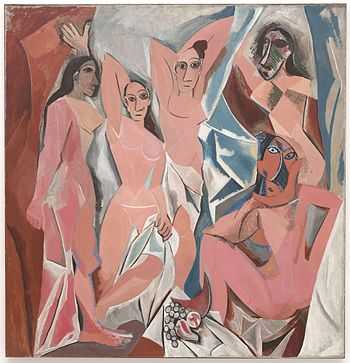
Pablo Picasso, Les Demoiselles d'Avignon, 1907, MoMA
References
- ↑ Boime, Albert (2007). Art in an Age of Civil Struggle. Los Angeles: The University of Chicago Press. p. 676. ISBN 978-0-226-06328-7.
- ↑ Musée d'Orsay, Le déjeuner sur l'herbe (Luncheon on the Grass)
- ↑ Details at www.artandarchitecture.co.uk
- ↑ Tucker, Paul Hayes (1998). Manet's Le Déjeuner Sur L'Herbe. Cambridge: Cambridge UP. p. 11.
- ↑ Tucker, Paul Hayes (1998). Manet's Le Déjeuner Sur L'Herbe. Cambridge: Cambridge UP. pp. 5–6.
- ↑ 6.0 6.1 6.2 Tucker, Paul Hayes (1998). Manet's Le Déjeuner Sur L'Herbe. Cambridge: Cambridge UP. p. 7.
- ↑ Armstrong, Carol (1998). "To Paint, To Point, To Pose" Manet's Le Déjeuner Sur L'Herbe. Cambridge: Cambridge UP. p. 93.
- ↑ Tucker, Paul Hayes (1998). Manet's Le Déjeuner Sur L'Herbe. Cambridge: Cambridge UP. p. 24.
- ↑ Armstrong, Carol (1998). "To Paint, To Point, To Pose" Manet's Le Déjeuner Sur L'Herbe. Cambridge: Cambridge UP. pp. 110–111.
- ↑ Armstrong, Carol (1998). "To Paint, To Point, To Pose" Manet's Le Déjeuner Sur L'Herbe. Cambridge: Cambridge UP. p. 111.
- ↑ Ross King. The Judgement of Paris: The Revolutionary Decade that Gave the World Impressionism. New York: Waller & Company, 2006 ISBN 0-8027-1466-8.
- ↑ Ross King, p.41
- ↑ Paul Hayes Tucker, Manet's Le Déjeuner sur l'herbe, Cambridge University Press, 1998, pp.12-14. ISBN 0-521-47466-3.
- ↑ John Rewald,The History of Impressionism, The Museum of Modern Art, 4th revised edition 1973, (1st 1946, 2nd 1955, 3rd 1961), p.85. ISBN 0-87070-369-2.
- ↑ Laessøe, Rolf (2005). "Édouard Manet's "Le Déjeuner Sur L'Herbe" as a Veiled Allegory of Painting". Artibus Et Historiae 26 (51): 197.
- ↑ Fried, Michael (1996). Manet's Modernism or, The Face of Painting in the 1860s. Chicago: The University of Chicago Press. p. 56.
- ↑ Fried, Michael (1996). Manet's Modernism or, The Face of Painting in the 1860s. Chicago: The University of Chicago Press. p. 57.
- ↑ McCauley, Anne (1998). "Sex and the Salon" Manet's Le Déjeuner Sur L'Herbe. Cambridge: Cambridge UP. p. 41.
- ↑ 19.0 19.1 19.2 19.3 McCauley, Anne (1998). "Sex and the Salon" Manet's Le Déjeuner Sur L'Herbe. Cambridge: Cambridge UP. p. 42.
- ↑ Peter J. Gartner, Art and Architecture: Musee D'Orsay, 2001, p.180. ISBN 0-7607-2889-5.
- ↑ 21.0 21.1 21.2 21.3 21.4 McCauley, Anne (1998). "Sex and the Salon" Manet's Le Déjeuner Sur L'Herbe. Cambridge: Cambridge UP. p. 43.
- ↑ McCauley, Anne (1998). "Sex and the Salon" Manet's Le Déjeuner Sur L'Herbe. Cambridge: Cambridge UP. p. 44.
- ↑ Émile Zola, Édouard Manet, 1867, et lps 91
- ↑ Émile Zola, Édouard Manet, 1867, link to English translation
- ↑ Locke, Nancy (1998). "Le Déjeuner Sur L'Herbe as a Family Romance" Manet's Le Déjeuner Sur L'Herbe. Cambridge: Cambridge UP. p. 121.
- ↑ Paul Cézanne, Le Déjeuner sur l'herbe (1876-1877), Musée de l'Orangerie, Paris
- ↑ Picasso: Challenging the past National Gallery exhibition book, p. 116
External links
|
|
- Le déjeuner sur l'herbe (Luncheon on the Grass), Musée d'Orsay, Full entry
- Impressionism: a centenary exhibition, an exhibition catalog from The Metropolitan Museum of Art (fully available online as PDF), which contains material on this painting (p. 131-134)
 Media related to Le Déjeuner sur l'herbe by Manet at Wikimedia Commons
Media related to Le Déjeuner sur l'herbe by Manet at Wikimedia Commons
| ||||||||||||
